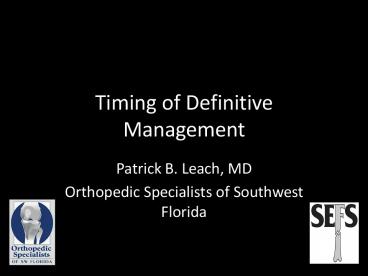Timing of Definitive Management PowerPoint PPT Presentation
1 / 30
Title: Timing of Definitive Management
1
Timing of Definitive Management
- Patrick B. Leach, MD
- Orthopedic Specialists of Southwest Florida
2
Damage Control Orthopaedics (DCO)
- Extension of concept developed in abdominal
surgery - Attempt to improve outcomes in patients with
triad of hyporthermia, acidosis, and coagulopathy - Prevention of SIRS (Systemic Inflammatory
Response Syndrome)
3
Focuses
- Control of hemorrhage
- Management of soft-tissue injury
- Achievement of provisional fracture stability
- Avoiding additional insult to patient
4
Benefits of DCO
- Win Win for patient and surgeon
- Allows for definitive fracture fixation when both
patient and surgeon are optimized for best
outcomes - Allows for standardization of initial management
and subsequent transfer to tertiary care center
5
Venti Red-Eye
6
AED or Cardizem
7
Patient Selection
- Remains a clinical decision
- Biomechanical and genetic markers can predict but
testing is not practical - No trauma scoring system that assists in
decision-making during the acute resuscitation
phase
8
Patient Selection
- Stable
- Borderline
- Unstable
- In extremis
9
Patient Selection
- Polytrauma injury severity score of gt20 points
and additional thoracic trauma - (abbreviated injury score gt2 points)
- Polytrauma with abdominal/pelvic trauma (Moore
score75 gt3 points) and hemorrhagic - shock (initial blood pressure lt90 mm Hg)
- Injury severity score of 40 points in the
absence of additional thoracic injury - Radiographic findings of bilateral lung contusion
- Initial mean pulmonary arterial pressure of gt24
mm Hg - Increase of gt6 mm Hg in pulmonary arterial
pressure during intramedullary nailing
10
Patient Selection
- Criteria you can remember
- pH lt7.24
- Temperature lt35oC
- Operative time gt90 minutes
- Coagulopathy
- Transfusion gt10 PRBCs
- Geriatric patient (physiologic age gt65)
11
Pelvic Fractures
- Sheet or binder very effective initial management
- Add traction pin for vertically unstable pelvic
fractures - Angiography or packing
- Exploratory laparotomy offers opportunity for
anterior fixation
12
Femur Fractures
- Consider associated head and/or chest injuries
- Cautious with bilateral femur fractures
- 2 differences between ex/fix and IM nail
- Reaming
- Surgical time
13
Limb Damage Control Orthopaedics
- DCO principles applied to a single, severely
injured limb - High energy tibial plateau fractures
- Tibial plafond fractures
- Grade III B and C open fractures
- Mangled extremties
14
Secondary Procedures
- Days 2, 3, and 4 are not recommended
- Objective tests
- Lactic acid/pH
- Coagulation studies
- IL-6
- HLA-DR class-II molecules
15
(No Transcript)
16
Orthopaedic Emergencies
- Dislocations
- Vascular compromise
- Compartment syndrome
- Hemodynamically unstable pelvic fractures
17
Dislocations
- Closed reduction with staged definitive
management - Dislocations associated with fractures
- Proximal humerus fracture with humeral head
dislocation - Femoral neck fracture with hip dislocation
18
Dislocations
19
Vascular Compromise
- Penetrating injuries
- Mangled extremity
- Spaghetti wrist
- Knee dislocations
20
Compartment Syndrome
- When in doubt, release
21
Orthopaedic Urgencies
- Open fractures
- Soft tissue injuries
- Displaced fractures
- Femoral neck fractures
- Talar neck fractures
- Pediatric supracondylar humerus fractures
22
Open Fracture
- When to debride?
- When to fix?
- When to close/cover?
23
Timing of Debridement
- 6 hour rule based on Freidrichs study of
bacteria replication rates - Only one study supports the 6 hour rule, while
seven studies over the last 30 years show no
significant difference - No published level I studies comparing early vs.
late debridement, and would be very difficult to
perform
24
Timing of Debridement
- LEAP study
- Measured outcome was incidence of infection
within first 6 months - Time to debridement did not predict infection
- Time to admission did correlate with infection
- Antibiotic administration
- Resuscitation
25
Timing of Debridement
- Ultimately, quality of debridement is most
important
26
Timing of Fixation
- May be performed at time of initial debridement
for grade I, II, IIIa fractures - Consider delayed fixation for fractures grossly
contaminated with dirt, stagnant water or
farmyard related injuries. - Delayed fixation and utilization of bead pouches
and/or VAC dressings for fractures requiring soft
tissue coverage - Reaming of open fractures well supported
27
Timing of Closure
- The early closure of open fractures grade I, II,
IIIa is recommended with the exception of wounds
grossly contaminated with dirt, stagnant water or
farmyard related injuries - Second look debridement warranted when there is
concern for further tissue compromise or high
initial contamination - Free flaps may outperform local flaps
28
Timing of Closure
- Cultures in acute open fractures have not been
shown to correlate with the development of
infection or with the ID of bacteria when
infection occurs - Postdebridement cultures have theoretical value
29
Conclusion
- Damage Control Orthopaedics (DCO) should always
be considered as an alternative to Early Total
Care (ETC) - DCO principles can be applied to the multi-trauma
patient or the severly traumatized single
extremity - Unresolved issues
- What constitutes the borderline patient
- Optimal management of femur fractures with
associated head and/or chest trauma
30
Thank You!

